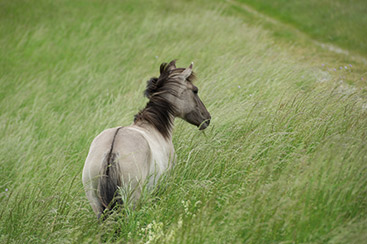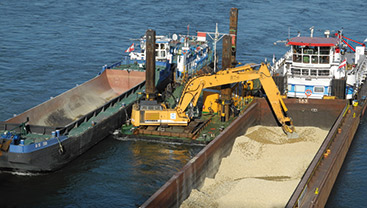A return to nature: river revitalisation efforts in Austria

A return to nature: river revitalisation efforts in Austria
Recent projects along the Danube and its tributaries are working to restore riverbanks, preserve habitats and protect biodiversity by bringing natural dynamics back to the river.

A small herd of rugged Konik horses, closely related to the
extinct European wild horse, has been reintroduced to a
reserve near Marchegg as part of an innovative grassland
management plan where their grazing activities will help
create ideal living conditions for a host of wildlife.
© Schickhofer
Since the 16th century, people have been
changing the natural course of the rivers
in the Danube River Basin, mainly for flood
defence, hydropower generation and
navigation. These changes have drastically
altered the Danube and its tributaries,
reducing habitats and endangering
a number of species. To combat these effects, several projects in Austria are
working to rebuild environmental features
and reintroduce wildlife by restoring the
natural functions of the river.
Wachau Valley. A five-year project which began this January aims to restore floodplain forests and protect important flora and fauna in the Wachau Valley, one of the last free-flowing sections of the Austrian Danube.
The project, called Wilderness Wetland Wachau, is coordinated by Austrian waterway company viadonau and supported by Life+. It will establish two new protected wilderness areas on the islands of Pritzenau and Schönbühel. The project will include work to create a 1.4km free-flowing sidearm and introduce a new inflow/overflow area to an existing sidearm, as well as build approximately 2.8km of new natural riverbanks along side arms.
Much work will also be done to create or restore habitats, including creating 20 ponds to be used as spawning grounds for amphibians and installing four artificial nests for White-tailed Eagles. The project will also aid the conservation of the Black Poplar by reforesting with saplings and restricting the use of 300-year-old trees.
Once the project is completed it is expected to improve the conservation status of several species protected under the EU Habitat and Birds Directives by restoring the floodplain forests and reconnecting those floodplains back to the river.
Lower Morava floodplains. Regulation measures over the last century have left limited habitats for nowendangered flora and fauna and downgraded the river to ‘moderate status’ according to the EU Water Framework Directive. A six-year project begun in 2011, supported by the Life+ project and led by project partners viadonau, WWF Austria and the Fishery Council of Lower Austria, aims to restore floodplains on the Lower Morava between Angern and the confluence at Markthof.
The project’s most important objective is to restore river dynamics by re-establishing the characteristic island landscape and improving connectivity. Altogether 8km of river branches will be revitalised and six branches which have been artificially cut off will be reconnected, benefitting fish as well as aquatic birds. In addition, cropland surrounding the restoration areas will be converted into grassland and measures will be taken to control the introduction and spread of invasive species such as Maple Ash to conserve the floodplain forest. Further work will set up measures to preserve habitats for species such as storks, kites, eagles and common terns, and to stabilise the population of European Weather Loach.
One aim of the project which has already been successful, to reintroduce Konik horses to a reserve near Marchegg as part of an innovative grassland management plan. This small yet rugged breed of horse is closely related to the extinct European wild horse and is well suited to the conditions of the area. After being introduced to the reserve in May 2015, the horses will maintain the landscape of a vast meadow area through their natural grazing, improving habitats for insects and the bird species that prey on them. The reserve is designed to allow the horses to meet their basic needs on their own and live out their lives naturally.
The project has nearly reached its half-way point and the next stage will be to secure approval from the Slovakian side for further restoration measures, as defined in a bilateral treaty regarding water management issues on the Morava River. Once the project is completed, it is expected to revitalise an area of about 200 hectares, improving at least seven pan-European habitats and benefiting 26 species under the EU Habitats and Birds Directives.
Bad Deutsch-Altenburg. The stretch of the Danube
between Vienna and the Slovakian border is a difficult
bottleneck for inland navigation. The continuous degradation
of the riverbed in this area – by up to 3.5cm
a year – has jeopardised the ecological balance of the
Donau-Auen National Park. To improve this stretch
of the river, the Integrated River Engineering Project
to the east of Vienna, coordinated by viadonau, was
created to balance the interests of navigation with ecological
needs. A pilot project was completed last year for a 3km
stretch of this area, providing valuable experience on revitalisation
measures, which can be applied to the whole area.

The continuous degradation
of the riverbed between
Vienna and the Slovakian
border – of up to 3.5cm a year – has jeopardised
the ecological balance of
the Donau-Auen National
Park.
©Toegel
The pilot project, Pilot Project Bad Deutsch-Altenburg, was co-financed under the Ten-T programme and construction on the project took place between February 2012 and July 2014. The pilot project tested Granulometric River Bed Improvement by adding larger gravel sizes (between 40mm and 70mm)) to reduce river bed erosion, which is expected to provide the river with better protection against further deepening.
The pilot project included work to reduce and reshape groynes for environmental optimisation, as well as to restore and lower riverbanks in two sections. Finally, the pilot project reconnected the Johler side arm. This 1.4km side arm is now the first permanent side arm in the national park.
Although construction on the pilot project has
finished, extensive monitoring of the work is ongoing
to evaluate the hydromorphological aspects of
the project, and a stakeholder forum was established
during the project to review progress and make recommendations
(see also interview DW 1/15). The forum
participants, along with the accompanying scientific
advisory board, issued a conclusion statement affirming
that the test made it possible to gather significant
knowledge, which is now needed to solve the remaining
challenges at the Danube east of Vienna.





